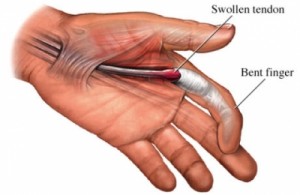
Trigger Finger Causes and Treatments
 Trigger finger, also known as stenosing tenosynovitis, occurs when one of your fingers or thumb gets stuck in a bent position and when straightened clicks or snaps, like a trigger being pulled and released. Symptoms can also include swelling of the finger and pain at the base of the finger or knuckle. Trigger finger, a condition seen more often in women than men, can affect people of all ages, but is most common between the ages of 40 and 60.
Trigger finger, also known as stenosing tenosynovitis, occurs when one of your fingers or thumb gets stuck in a bent position and when straightened clicks or snaps, like a trigger being pulled and released. Symptoms can also include swelling of the finger and pain at the base of the finger or knuckle. Trigger finger, a condition seen more often in women than men, can affect people of all ages, but is most common between the ages of 40 and 60.
Trigger finger is usually seen in people who use their hands in a repetitive manner, either at work or with their hobbies. Commonly effecting musicians, farmers, industrial or assembly workers, trigger fingers can also be caused by repetitive hobbies such as cross stitch and jewelry making. Hand use that is forceful, or sustained for long periods of time can also cause trigger fingers, and is common in woodworking and other professions where workers are grasping power or hand tools for long periods of time.
Repetitive hand use at work and in hobbies, is not the only cause of this condition. Problems such as gout, rheumatoid arthritis, and diabetes can predispose people to developing a trigger finger. In all these cases, trigger fingers are like a "wear" pattern, and overuse is a contributing factor.
Trigger finger is caused by the thickening or swelling of the tendon in the affected finger. Normally the tendon glides smoothly, without friction, through a protective sheath. Once swollen, the tendon no longer glides smoothly because the thickened, swollen tendon will not fit freely in the sheath. Trigger finger occurs when the tendon, thick or swollen, gets constricted in the sheath, no longer moves freely, and becomes inflamed and painful.
Treatment for trigger finger is very successful. Conservative care for trigger fingers includes a full evaluation by a physician specialized in treating trigger fingers. Xrays, medication such as NSAID or steroid injections, splinting of the finger at night to rest the tendon, discontinuing repetitive irritating activity, and discontinuing wearing jewelry at night on the effected finger can all be successful in alleviating pain. Hand therapy can also be very helpful in treating trigger finger.
If the trigger finger does not resolve with conservative care, surgery may be recommended. The procedure, performed as an outpatient, restores the smooth gliding of the tendon fairly quickly, and is very helpful in some cases. Often after a trigger finger release, hand therapy for 2 to 4 weeks is highly recommended to promote healing, decrease scar tissue, and educate people in joint protection techniques to prevent recurrence.
At MMI our four Certified Hand Therapists (CHT's) have extensive experience treating trigger fingers as well as injuries and conditions of the arm, hand, wrist and fingers. Our therapists have met the stringent training, experience, and examination requirements to receive their CHT credentials and offer a comprehensive hand rehabilitation program customized to fit each patient’s needs.